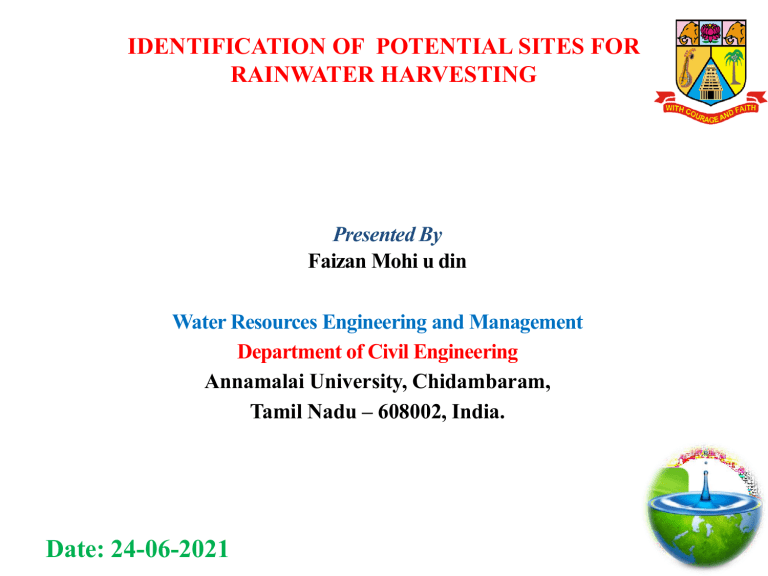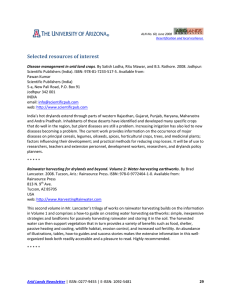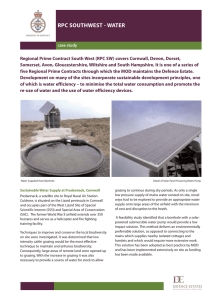
IDENTIFICATION OF POTENTIAL SITES FOR RAINWATER HARVESTING Presented By Faizan Mohi u din Water Resources Engineering and Management Department of Civil Engineering Annamalai University, Chidambaram, Tamil Nadu – 608002, India. Date: 24-06-2021 OUTLINE OF PRESENTATION Introduction Methodology GIS Analysis Results Conclusion Reference INTRODUCTION Rainwater harvesting is the technique of collection Rainwater from catchments and can be stored in tanks. Artificial Recharge is method by which the ground water is augmented at a rate much higher than those under natural condition of percolation. rainwater harvesting is having scope to improve the water scarcity problems among nations. It is significantly approached by many agencies and is introduced in various projects In the schedule, to find the potential of rainwater harvesting zones the locations are first identified which is based on slope, land use/land cover, watershed delineation, Digital elevation model, contour map, drainage density map, the runoff depth map, and soil texture Traditional and old practices were used for planning soil and water conservation interventions which is a time-consuming task. The selection of the rainwater harvesting process depends upon the six main factors; i.e. hydrology, topography, agronomy, soil, climate, and socio-economic conditions. METHODOLOGY Flow chart representing site suitability analysis STUDY AREA Latitude : 12° 55' 48.00" N Longitude : 79° 07' 48.00" E Area : 87.915 Sq km Population: 3936331 (Census:2011) Growing Industrial Area GIS ANALYSIS Land use/Land cover Map Soil Map GIS ANALYSIS Digital Elevation Map Contour Map GIS ANALYSIS Drainage Density Map Runoff Depth Map GIS ANALYSIS Slope Map RESULT AND DISCUSSION Suitability Map 40 35 Area ha 30 25 20 15 10 5 0 Restricted Not Suitable Moderate Suitable Suitable High Suitable Location map of potential sites RESULT AND DISCUSSION Location map of potential sites CONCLUSION Potential Zone Identification was Done By Using the Weighted Overlay Average Method in QGIS 3.18 Multi-layer Thematic Layers Such as Land Use/Land Cover, Soil Map, Slope Map, Digital Elevation Model, Drainage Network Map, And Runoff Depth Map were Integrated With a Projection Of EPSG 32644 WGS- 84 UTM ZONE 44N Projected Coordinate System Output Indicated that 39.77% (2416 Km2) Is a Restricted Area for Rainwater Harvesting, 29.87% (1815.62 Km2) is Not Suitable for Rainwater Harvesting While 19.98% (1214.25 Km2) and 10.08% (612.88 Km2) Is A Good Suitable Site for Opting Rainwater Harvesting and the Best Suitable Site Exhibit Only Small area where Is the Best Option for Harvesting which is of 0.18% (11.51 Km2) Location names for Site Suitability for RWH Ammur, Katpadi, Gudiyattam, Ambur And Vaniyambadi References Kim, R.H., S. Lee, Y.M. Kim, J.H. Lee, S. K. Kim and S. G Kim (2005). Pollutants In Rainwater Runoff In Korea: Their Impacts on Rainwater Utilization. Environmental Technology 26:11-420. Angrill, Sara, Farreny, Ramon, Dan Gason,(2011) Environment Analysis of Rainwater Infrastructures in Diffuse and Compact Urban Models In Mediterranean Climate, International Journal of Life Cycle Assess, Germany. Imroatul C. Juliana 1,(2013) A Review of Rainwater Harvesting System for Storm Water Management, The Second International Conference on Sustainable Infrastructure and Built Environment- Banding 19-20 November. Conway, D., & Schipper, E. L. F. (2011). Adaption to Climate in Africa: Challenge and opportunities identified from Ethiopia. Global Environment Change, 21, 227-237. Ammar Adham Ali (2016) University of Anbar identifaction of Suitable Sites for Rainwater Harvesting Structures In Arid And Semi- Arid Regions: A Review International Soil and Water Conservation Research 4 (2). Venkatesh, B. And M.K. Jose (2007). Identification of Homogeneous Rainfall Regimes in Parts of Western Ghats Regions of Karnataka. J. Earth. Syst. Sci. 116 (4):321-329 31


